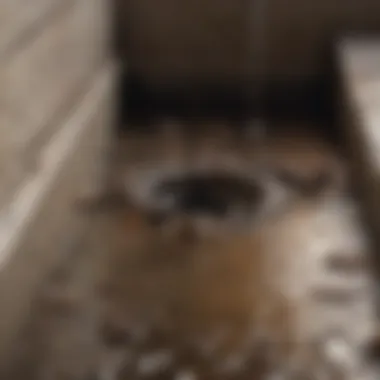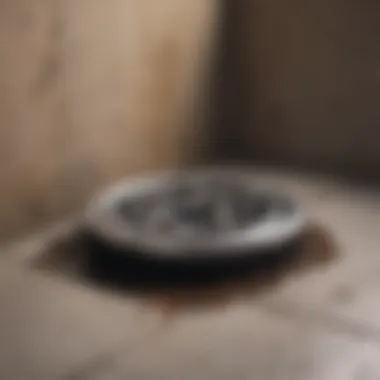Resolving Blocked Drains: A Comprehensive Guide


Intro
Blocked drains can pose significant challenges for homeowners. Understanding how to address these issues is crucial for maintaining functionality in plumbing systems. This guide provides insights into the most common causes of blockages, suitable solutions for DIY enthusiasts and when to seek professional help. Knowledge of these aspects will empower homeowners to approach plumbing problems with confidence, avoiding potential damage or further complications.
Featured Homes
While the focus here is on plumbing issues, unique architectural designs often present one-of-a-kind challenges regarding drainage. Some homes feature intricate gutter systems or multiple levels of plumbing where clogs can easily occur. Here are some unique aspects to consider:
- Spotlight on Unique Architectural Designs
Recognizing the architecture's role in drainage efficiency is vital. For example, mid-century modern homes with flat roofs may face specific drainage problems due to the lack of slope designed for proper water flow. Understanding how these design elements influence drainage can help in anticipating blockages. - Home Tours: Inside Stunning Interiors
A well-designed interior should be complemented by effective plumbing. Homeowners should take into account how their interior choices, such as thick carpets or expansive bathrooms, might impact drain performance. Clear understanding of this relationship is essential for maintaining both aesthetics and functionality.
Understanding Blocked Drains
Blocked drains arise from various factors. This section will explore these reasons and provide insight on how to resolve them effectively.
Common Causes of Blockages
Some typical culprits for blocked drains include:
- Hair and Fibers: Often accumulate in bathroom sinks and showers.
- Food Waste: Comes from kitchen sinks when not using strainers.
- Grease Build-Up: Accumulates over time in kitchen pipes.
By understanding these common causes, homeowners can take preventive measures to minimize the risk of blockages.
DIY Solutions
For those inclined to tackle issues themselves, several methods can effectively address blocked drains:
- Using a Plunger: Often the first line of defense.
- Chemical Drain Cleaners: Can provide fast relief but may damage pipes if used excessively.
- Plumbing Snake: A practical tool to clear out deeper clogs.
"Regular maintenance can prevent most drain blockages, sparing homeowners from costly repairs."
When to Call a Professional
It is essential to recognize when a blockage is beyond DIY solutions. Signs include:
- Recurring blockages despite attempted solutions.
- Unusual odors emanating from drains.
- Significant water backup issues.
In such cases, contacting professional plumbing services may save time and prevent damage to your property.
By understanding the significance of each aspect, homeowners can effectively address issues related to blocked drains, ensuring their systems remain functional._
Understanding Blocked Drains
Blocked drains are a common issue that can lead to significant inconveniences and potential damage to household plumbing systems. Understanding this topic is crucial for homeowners and renters who wish to maintain their property effectively. Knowledge about blocked drains empowers individuals to address problems efficiently, saving both time and money in the long run.
One of the key elements regarding blocked drains involves recognizing the factors that contribute to clogs. Blockages can arise from various sources, including the build-up of waste and debris over time. This understanding leads to proactive maintenance, helping to prevent issues before they escalate into more severe problems. Additionally, being aware of the specific types of drains that are prone to blockages can help in identifying vulnerable areas within a plumbing system.
Benefits of grasping the concept of blocked drains include:
- Timely intervention: Recognizing early signs of blockage can prevent costly repairs.
- Maintenance knowledge: Understanding preventive measures promotes better upkeep of plumbing systems.
- Informed decisions: Knowing when to attempt DIY solutions versus when to call a professional enhances problem-solving capabilities.
In essence, a thorough understanding of blocked drains helps individuals maintain their home's plumbing health, avoid significant disruptions, and ensure a smoothly functioning drainage system.
What Causes Blocked Drains?
Blocked drains commonly arise from several issues. The primary causes include:
- Hair: Often collects in bathroom drains, creating a mat that obstructs water flow.
- Food waste: Flushing down grease, oils, and other waste in kitchen sinks can lead to solidification and clogs.
- Soap scum: Soap residue can build up inside pipes, narrowing the passage for water.
- Foreign objects: Items like toys, sanitary products, or other debris can accidentally block drainage.
Understanding these causes is fundamental to preventing future blockages.


Types of Drains Prone to Blockage
Certain types of drains are more susceptible to blockages due to their specific functions and locations in a home. Common types include:
- Kitchen sinks: These are particularly prone due to grease and food remnants.
- Bathroom sinks and showers: Hair and soap scum are leading factors in these drains.
- Toilets: Improper flushing can lead to significant blockages.
- Outdoor drains: Leaves, dirt, and debris can gather and cause clogging in yard drains.
Being informed about these types can aid in ensuring better maintenance practices.
Signs Your Drain is Blocked
There are several indicators that a drain may be experiencing a blockage. Key signs include:
- Slow drainage: Water pooling or taking longer to go down suggests an issue.
- Unpleasant odors: Foul smells emanating from drains may indicate decomposing waste.
- Gurgling noises: Sounds of air moving through pipes can signal a partial blockage.
- Water backup: In severe cases, waste may back up into sinks or tubs.
It is essential to recognize these signs early, as addressing them promptly can save homeowners from more considerable disruptions and repairs.
"A proactive approach is the key to effective drain management. Understanding the causes and signs of blockages allows for timely action."
DIY Solutions for Blocked Drains
Blocked drains can induce significant inconvenience in daily life. Engaging in DIY solutions to clear these obstructions offers homeowners an avenue to regain control over their plumbing issues, avoiding potentially costly professional services. Understanding various approaches can empower individuals to tackle a range of drainage challenges effectively. Evaluating the specific benefits of DIY methods, such as cost-effectiveness, immediate results, and the satisfaction of solving a problem independently, contributes to a more favorable perspective on plumbing maintenance.
Using a Plunger Effectively
The plunger is one of the most recognizable tools for dealing with clogged drains. This method is generally effective for mild to moderate blockages. To maximize efficiency, position the plunger over the drain, ensuring that it forms a tight seal around the opening. Utilizing quick, vigorous up-and-down motions can create suction and pressure that may dislodge the obstruction. It is crucial to keep the water level sufficient to cover the plunger's cup to enhance the tool's effectiveness. In cases of kitchen sinks or toilets, persistently applying force can often free the blockage.
Employing a Drain Snake
For stubborn clogs that resist a plunger, a drain snake may be required. This tool consists of a long, flexible wire capable of navigating bends in pipes to reach deeper blockages. To use a drain snake, insert the end of the cable into the drain and gently twist it while pushing forward. Once resistance is felt, it usually indicates that the snake has reached the blockage. Turning the handle can help break apart or capture the obstruction, allowing it to be pulled out. It's advisable to wear gloves during this process to maintain hygiene.
Chemical Drain Cleaners: Pros and Cons
Chemical drain cleaners are commercially available solutions that promise quick blockage removal. These products typically contain powerful chemicals designed to dissolve organic materials causing clogs. However, while they can provide immediate relief, there are notable downsides.
Pros:
- Fast-acting solution for many types of blockages.
- Easy to use; usually involves pouring the cleaner down the drain and waiting.
Cons:
- Harsh chemicals can damage pipes over time.
- Potential health risks, including fumes that may irritate skin or lungs.
- Environmental concerns related to chemical disposal.
Given these factors, it is prudent to consider other solutions before resorting to chemical options.
Boiling Water Method
Using boiling water to tackle blockages is a simple and effective technique for certain types of clogs, particularly those formed by grease or soap residue. To implement this method, boil a kettle of water and carefully pour it down the drain in stages. Allowing the hot water to work through the blockage can help dissolve any build-up. While this method has limited effectiveness on more severe clogs, it is a non-toxic option that often provides immediate results without the risks associated with chemical cleaners.
"Regularly using boiling water can help keep drains clear and minimize future blockages."
In summary, the selection of a DIY solution depends greatly on the type and severity of the blockage encountered. By understanding these methods, homeowners can approach their plumbing issues with confidence.
Preventive Measures to Avoid Blocked Drains
Preventing blocked drains is essential for maintaining a smoothly operating plumbing system. Engaging in preventive measures minimizes the risk of blockages and can save homeowners from expensive repairs in the long run. It is crucial to understand the causes of drain blockages to effectively prevent them. Several factors contribute to drains becoming blocked over time, including the accumulation of debris and improper use of sinks and toilets. By implementing a few key practices, homeowners can maintain clear and functional drainage systems.
Regular Maintenance Practices
Regular maintenance is the backbone of effective drainage system management. Simple tasks performed routinely can greatly diminish the likelihood of clogs. Homeowners should pay attention to their plumbing to catch minor issues before they escalate into major problems.
- Routine Cleaning: Clean drains regularly by removing hair, food particles, and other debris. This task can often be managed easily with a simple drain cleaner or a manual removal tool.
- Flushing with Water: Occasionally flushing drains with hot water can help dissolve grease and soap residues. This is particularly important in kitchen sinks where oily substances tend to build up.
- Seasonal Check-Ups: Performing seasonal inspections of plumbing can reveal signs of wear and tear. Consider checking for leaks, strange noises, or slow drainage.
- Using Drain Covers: Installing drain covers or screens can catch debris before they enter the drain, providing an easy prevention method that requires minimal effort.


By adopting these practices consistently, homeowners create a proactive approach that leads to less hassle and mitigates drainage issues.
What Not to Flush or Pour Down Drains
Even with preventive maintenance, improper disposal practices can lead to blocked drains. Understanding what not to flush or pour is critical in maintaining healthy drainage systems.
- Feminine Hygiene Products: These items do not break down and can cause severe blockages.
- Paper Towels: Unlike toilet paper, paper towels do not disintegrate easily in water and can quickly lead to clogs.
- Grease and Oil: Pouring fats down the sink can solidify in pipes and trap food particles, leading to blockages.
- Food Scraps: Even small amounts of food can accumulate. It’s advisable to use a compost bin instead to manage food waste.
"What goes down your drains can have a direct impact on your plumbing system. Make conscious choices to ensure its longevity."
By adhering to these guidelines, homeowners can significantly reduce the risk of future blockages, promoting a healthier and more reliable plumbing system.
When to Call a Professional
Recognizing when to consult a professional for drain issues is crucial for effective management of plumbing problems. While many homeowners may attempt to resolve blockages on their own, some situations demand expertise. Ignoring serious issues can lead to more significant damage and costly repairs. This section details the indicators suggesting that a professional evaluation is needed, outlining potential benefits and considerations for homeowners.
Identifying Serious Drain Problems
Certain signs may indicate that the drain problem exceeds standard blockages. Some of the serious issues include:
- Persistent Backups: If draining does not improve after multiple DIY attempts, professional intervention is likely required.
- Foul Odors: Unpleasant smells can signal underlying problems, such as a broken sewer line or severe buildup in the pipes.
- Overflowing Toilets or Sinks: Frequent overflow points to significant drainage issues that could potentially lead to property damage.
- Wet Spots Around Fixtures: Water pooling around sinks or toilets may indicate leaks that need urgent repair.
Proactivity in seeking professional help can prevent further complications, maintaining the integrity of your home’s plumbing system.
Understanding the Costs of Professional Help
Understanding the financial implications of hiring a professional can help homeowners make an informed decision. The costs involved may vary widely. Factors that often influence pricing include:
- Severity of the Problem: More extensive issues may require additional labor and materials, leading to higher costs.
- Location: Rates may differ based on geographic areas and local market conditions.
- Type of Service: Different plumbers may charge differently based on experience or expertise.
On average, plumbing services can range from $100 to $500 for basic repairs. For major repairs or services like camera inspections, costs can increase significantly. Transparency in pricing and the overall scope of work is essential when hiring professionals.
Factors to Consider When Hiring a Plumber
Choosing a licensed plumber is vital for ensuring quality work. Consider the following points:
- Licensing and Insurance: Ensure the plumber has proper credentials to perform the work legally.
- Experience: Look for professionals experienced in dealing with drain issues similar to yours.
- References and Reviews: Check past customer experiences to gauge reliability and service quality. Platforms such as Facebook or Reddit can offer insights into local services.
- Written Estimates: Before commencing work, obtain a detailed estimate. It should include labor, materials, and any potential additional costs.
Evaluating these factors can help ensure you're making a sound decision when hiring someone to handle your plumbing issues. Taking time to research prevents frustrating and costly mistakes.
Tools and Equipment for Drain Fixing
When dealing with blocked drains, understanding the appropriate tools and equipment is crucial. The right tools can significantly impact the efficiency and effectiveness of your efforts to resolve drainage issues. This section explores both essential tools that every homeowner should have and situations when more specialized equipment is needed.
Essential Tools for Homeowners
Homeowners often overlook the importance of having the correct tools on hand. Here are some essential tools every household should consider:
- Plunger: A versatile tool suitable for minor clogs. Its design helps create suction to dislodge blockages in sinks, toilets, and showers.
- Drain Snake: Also known as a plumber’s snake, this tool effectively reaches deep into pipes, breaking up or pulling out debris that may be causing blockages.
- Handheld Auger: This tool is ideal for tougher obstructions that are not responsive to a typical drain snake. Its spiral design allows for deeper penetration in drains.
- Bucket: A simple yet essential item to manage spills when cleaning blocked drains. It also helps to catch debris removed from the system effectively.
- Gloves: Wearing gloves is crucial for hygiene and safety while dealing with dirty drains.
- Drain Cleaning Solution: While not strictly a tool, an eco-friendly and effective drain cleaner can serve as a first line of defense against minor clogs.
By possessing these essential tools, homeowners can tackle common blockages without relying on outside help. Understanding how to use these tools effectively is just as important as having them.
When Specialized Equipment is Necessary
Despite having essential tools, there are circumstances that call for more advanced equipment. This helps target more severe or stubborn blockages. Consider the following scenarios:
- Camera Inspection: This specialized equipment allows for a thorough view inside the pipes. A camera can help diagnose the exact cause of a blockage, such as tree roots or structural issues.
- Hydro Jetting: When traditional methods fail, hydro jetting uses high-pressure water streams to clear away blockages and buildup inside the pipes, restoring proper flow.
- Electric Drain Cleaners: These provide stronger and more efficient cleaning solutions for serious blockages. They utilize electric power to maneuver cables and clear stubborn obstructions.
- Sewer Line Inspection Tools: When there are potential issues within the main sewer line, professional equipment is necessary. Problems here can lead to health hazards and significant property damage.
Using specialized equipment further enhances the ability to resolve complex drain problems. However, it typically requires professional intervention, given the risks and equipment costs involved.
Effective management of drain issues requires both the right tools and an understanding of when to escalate to specialized solutions.


Having a proper toolset allows homeowners to address minor drainage issues, while recognizing when advanced equipment is necessary can prevent larger problems down the line. Understanding these tools plays an essential role in taking proactive measures in drain maintenance.
Understanding Drainage Systems
Understanding drainage systems is crucial in the context of resolving blocked drains. These systems are the backbone of wastewater management in a residential setting. They ensure that excess water and waste are efficiently channeled away from homes and into municipal sewer systems or septic tanks. Moreover, a well-functioning drainage system prevents damages caused by flooding and minimizes health risks related to stagnant water.
Several elements make up a drainage system, including pipes, fittings, drainage fields, and access points. Grasping how each component operates will provide insights into diagnosing issues effectively. Some benefits of comprehending drainage systems include better maintenance choices, informed decisions during renovations, and the ability to identify potential problems before they escalate.
Components of a Drainage System
A drainage system consists of various components that work in tandem to ensure efficiency. Here are the main components:
- Pipes: These are the conduits that transport wastewater. They come in various materials, but PVC and cast iron are commonly used.
- Fittings: These are components such as elbows, tees, and couplings that connect pipes at different angles or junctions.
- Drainage Field: In septic systems, this area disperses treated effluent into the soil. It plays a vital role in wastewater filtration.
- Access Points: These include cleanouts and inspection ports, which allow for maintenance and clearing of blockages.
By understanding these components, homeowners can better appreciate the system's functionality.
How Drains Work
Drains operate through a combination of gravity and pressure. When water flows from sinks, toilets, and showers, it travels down pipes, aided by gravity. Wastewater moves toward the drainage field or sewer line, where it undergoes treatment.
Proper drainage depends on several factors:
- Slope: Pipes are usually installed at a specific slope to promote flow.
- Ventilation: Vent pipes allow air to enter the drainage system, ensuring that wastewater flows freely without pressure build-up.
- Trap: Plumbing traps prevent sewer gases from entering homes while retaining water to block odor.
Understanding these principles is vital for diagnosing and resolving any drainage issues, ensuring that homeowners can act swiftly when faced with blockages.
Environmental Considerations
Understanding the impact of blocked drains extends beyond immediate plumbing concerns. Environmental considerations play a crucial role in enhancing the longevity and efficiency of drainage systems while maintaining ecological balance. Blocked drains not only disrupt daily activities but can also lead to significant environmental issues.
One important factor to consider is the impact of wastewater. When drains are blocked, wastewater often backs up, potentially spilling into public spaces or natural ecosystems. This can cause pollution, disrupting local wildlife and contaminating water sources. Hence, regular attention to drain maintenance contributes to a more sustainable environment.
Moreover, the methods used to unclog drains can affect the environment. Many traditional drain cleaning solutions contain harsh chemicals which can be detrimental to both the plumbing system and surrounding ecosystems. As the world increasingly focuses on sustainability, it is vital to explore and adopt eco-friendly alternatives.
The benefits of environmentally-friendly drain cleaning methods are significant. Not only do they minimize negative impacts on the environment, but they can also be safer for users and more effective in the long-term. People can reduce their carbon footprint by choosing sustainable products and methods.
Furthermore, we must consider the long-term health of the drainage systems. Regularly utilizing eco-friendly products helps prevent the buildup of damaging materials, preserving the integrity of pipes. Proper maintenance enhances the efficiency of the system, which subsequently makes it less likely to fails or develop blockages.
It is worth noting that local regulations may guide the disposal of wastewater and cleaning chemicals. Awareness of these regulations ensures that homeowners comply with legal requirements, fostering responsible drain care.
"Using eco-friendly alternatives for drain maintenance is not just a choice; it's a necessity for sustainable living."
Next, let’s explore Eco-Friendly Drain Cleaning Alternatives that effectively address blockages without harming the environment.
Closure: Effective Drain Maintenance
Drain maintenance is crucial for ensuring that plumbing systems function optimally. It not only prevents blockages but also extends the life of your drainage infrastructure. By understanding the proper upkeep of your drains, homeowners can avoid the need for costly repairs or professional interventions. Regular check-ups can help detect early signs of problems, allowing for timely corrective measures.
The benefits of effective drain maintenance include reducing the chances of overflow issues, preventing unpleasant odors, and maintaining the overall hygiene of your home. Questions often arise about how frequently maintenance should occur. Typically, routine inspections every six months are recommended, with additional checks if you notice any warning signs.
Considerations about drain maintenance also encompass environmental impacts. By utilizing eco-friendly methods, you contribute positively to the ecosystem while safeguarding your plumbing. Maintaining awareness about what can and cannot be disposed of down your drains, such as fats or certain chemicals, is essential. No matter how small these practices may seem, they have substantial cumulative effects on your drainage systems.
"Effective maintenance not only saves money but also promotes a healthier living environment."
Summarizing Key Takeaways
In summary, the exploration of blocked drains reveals the complexities involved in their management. Remember these key takeaways:
- Know the Causes: Understanding why drains get blocked empowers homeowners to take preventive steps.
- DIY Solutions: Familiarize yourself with basic tools and methods to effectively handle minor blockages.
- Professional Help: Know when it is appropriate to contact plumbing professionals for serious issues.
- Preventative Measures: Regular maintenance and awareness of what goes down the drain can save you time and money.
- Environmentally Friendly: Use eco-conscious methods in your maintenance to contribute positively to the environment.
Future Steps for Drain Care
To ensure long-lasting drain health, consider the following future steps:
- Education and Awareness: Stay informed about drain maintenance procedures. Reading and conducting research can provide insights that help maintain your drainage system.
- Schedule Regular Inspections: Like any other maintenance task in a home, include drain inspections in your yearly home maintenance checklist.
- Practical Tools: Invest in quality drain cleaning tools. A good plunger, drain snake, or eco-friendly cleaner can make the difference in handling a minor blockage efficiently.
- Correct Disposal: Always know what not to put down the drain. This includes heavy oils, food remnants, and chemical cleaners that may cause corrosion or blockages.
- Engage Professional Services: If problems persist despite your best efforts, seek licensed professionals. Their expertise and specialized equipment can often resolve what DIY methods cannot.
By taking these steps, homeowners can effectively maintain their drainage systems and prevent the issue of blocked drains from affecting their lives.







